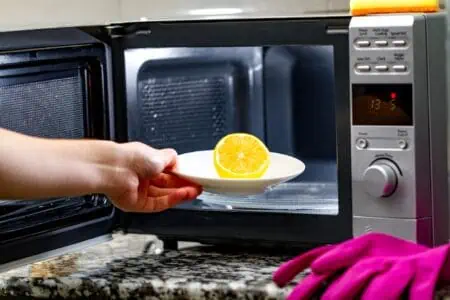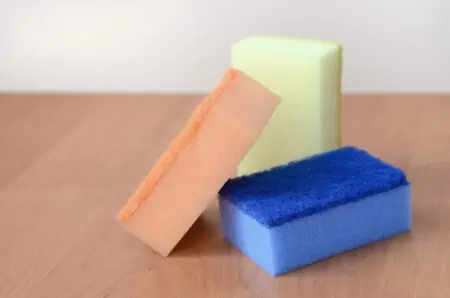If you’re anything like us, you use your microwave daily. You couldn’t live without it. But one major drawback is that it starts to smell pretty bad pretty quickly.
If your microwave smells weird, we can help. Follow our method for how to get smells out of a microwave, and you’ll be so thankful you tried this easy hack.
Next time you go to reheat last night’s leftovers, you won’t be cringing at the smell. And it only takes 10 minutes!
Key Takeaways
- Mix water and vinegar in a microwavable container, heat for 90 seconds, and let stand for three minutes before wiping the microwave interior.
- Use baking soda overnight in the microwave to neutralize remaining odors.
- Regularly clean the microwave and cover food while heating to prevent bad smells.
- Avoid using bleach inside the microwave, as it can damage the plastic and leave harmful residue.
Why Does My Microwave Smell?
When you heat food, the moisture evaporates and sticks to the inside of the appliance. The residue left behind leaves a smell. This can be particularly noticeable with certain foods like fish, bacon, and popcorn, as they have a distinct odor.
When you overcook food, it can leave behind a scorched smell. When you use the microwave again, it can further burn these particles, perpetuating the odor problem.
Another reason for a stinky microwave is mold. This can occur if the microwave has trapped moisture for a while.
Finally, your microwave might be radiating a hot copper smell. This is usually due to burnt plastic or burnt wire. If this occurs, unplug the microwave and don’t use it again. It will need to be repaired or replaced.
How To Get Smells Out of a Microwave With Vinegar
Vinegar is our favorite method for cleaning the microwave. You can use it on its own or combine it with baking soda for even more cleaning power.
- Time: 10 to 15 minutes.
- Difficulty: Easy.
What You’ll Need
- A microwave-safe cup.
- Three tablespoons of distilled white vinegar.
- Water.
- A cloth.
- A spoon.
- Bowl.
- Baking soda.
- Lemons (optional).
1. Prepare the Mixture
This is the microwave cleaning method we use in our house, and it works like a charm. Mix four ounces of water and three tablespoons of vinegar in a cup. Stir with a spoon.
Try This
If you don’t have vinegar, combine four teaspoons of lemon juice per cup of water.
2. Heat the Mixture
Place the cup in the microwave and heat it for 90 seconds. Keep an eye on it — if it starts to boil and bubble over, stop the cycle.
If using lemon juice, heat the solution for four minutes or until it boils.
3. Wait
Leave the mixture in the microwave for three minutes. This gives the steam time to coat the microwave and work at the stains and odors.
4. Clean
Carefully remove the cup — it might be hot, so wear an oven glove if necessary. Use a cloth to clean down the loosened debris. The vinegar will have made it super easy to clean; this step is so satisfying!
5. Leave Baking Soda Overnight
If smells persist, pour one cup of baking soda into a bowl and leave it in the microwave overnight. No need to switch it on — simply letting it sit will neutralize any remaining odors!
6. Repeat
If the smells persist, repeat the entire process once or twice more.
How To Deodorize a Microwave Naturally
We’re all about organic odor removal. The vinegar method uses no harsh chemicals, and it works a charm. But if you want to deodorize without vinegar, other natural products work great.
With Coffee
Wondering how to put your used coffee grounds to use? Well, they can neutralize odors and remove burnt smells from a microwave. Here’s how:
- Prepare the mixture: In a small bowl, combine two tablespoons of ground (used or fresh) coffee with ½ cup of water.
- Microwave the mixture: Place the bowl in the microwave and run it for three minutes. Make sure it doesn’t boil over. You can repeat the process up to three times — just ensure the water hasn’t evaporated. If it has, add more water.
- Clean: Remove the bowl carefully. Wipe down the inside of the microwave to remove loosened debris and condensation.
- Repeat: If necessary, repeat the process.
With Vanilla Extract
If you like super sweet smells, learn how to get odors out of a microwave with vanilla. We used this tip, and it really worked! But the house smelt like vanilla for days — so if you aren’t sure about that, be careful.
- Prepare: Pour three teaspoons of vanilla extract into a shallow bowl.
- Heat: Heat the vanilla for 30 seconds.
- Remove: Remove the bowl, and that’s it — your microwave is deodorized!
You should always use real 100 percent vanilla extract rather than manufactured vanilla. This also is a deodorizer rather than a microwave cleaner. So clean your microwave of food residue first — then try this method.
Warning
If you hear bubbling, end the cycle. This is a sign that the vanilla is burning, which will lead to even worse smells.
With Charcoal
Charcoal is naturally absorbent, so it will tackle odors quickly and effectively.
- Gather charcoal: You can use leftover charcoal from your grill, large charcoal pieces, or charcoal bags. If using charcoal pieces, cut them up and put them in a bowl.
- Place charcoal in the microwave: Place the charcoal pieces or bags in the microwave and leave them overnight. This gives the charcoal time to absorb stinky smells.
- Remove: In the morning, remove the charcoal from the microwave. Give your microwave a sniff. If the odors remain, try a different method.
You can keep the charcoal nearby and pop it in the microwave between uses. This allows it to tackle smells before they build up.
With Cloves
Cloves are another naturally absorbent ingredient that can suck foul odors right out of your microwave. Here’s how to use them:
- Place cloves in a bowl: Pour ¼ cup of cloves (whole or ground) into a bowl. Pop it in the microwave.
- Wait: Leave the cloves in the microwave overnight to absorb the odors. Between uses, you can pop the cloves back in to remove odors.
With Berries
After deep cleaning your microwave, you can use berries to help cover lingering odors. Plus, they leave a nice scent, so your house will smell lovely.
- Fill a bowl: Fill a bowl with berries — any berries will do! Just ensure they aren’t protruding over the top of the bowl.
- Cover: Cover the bowl with plastic wrap, ensuring that the berries aren’t touching the plastic. Make sure the plastic is tight.
- Heat: Heat the berries in the microwave for two minutes. This will fill the microwave and your kitchen with a nice scent. If you want more of a scent, put the berries on blast for another minute.
Note that this method might mask odors rather than eliminate them entirely. We recommend deep cleaning and deodorizing your microwave first. We also recommend strawberries and raspberries if you want a strong scent.
Be Careful
Don’t eat the berries after using this method. The plastic might have melted on them a little, making them unsafe to ingest.
With Oranges
Citrus is an amazing burnt odor eliminator. Plus, it leaves behind a fresh aroma. This method takes a little longer than the other methods, but if you love citrus scents, this is worth a go.
- Slice your fruit: Cut the oranges into small pieces. While oranges are amazing, you can also use lemon, grapefruit, or a combination!
- Prepare the bowl: Place the fruit into a bowl and fill it with water.
- Heat: Place the bowl in the microwave and heat for two minutes.
- Wait: Leave the bowl to sit for another five minutes. This allows the steam to coat the inside of the microwave.
- Check: Check if the odors are gone from the microwave. If not, you can repeat this process up to three more times.
- Wipe clean: Wipe the inside of the microwave clean with a cloth.
- Use baking soda: If the smell persists, add a teaspoon of baking soda to the fruit bowl. Add more water if necessary.
- Heat: Heat the bowl for another minute. Keep an eye on the bowl to ensure the baking soda doesn’t overflow. If so, cancel the cycle.
- Wipe clean: Once again, wipe down the microwave. It should now be free of odors.
Tips For Preventing Bad Smells in a Microwave
You know how to get rid of smells in a microwave. But it’s even easier if you prevent them in the first place. Here are five tips for keeping your microwave fresh:
- Use baking soda between uses: Keep a cup of baking soda nearby and place it in the microwave between uses. Make sure to switch it out for fresh baking soda every few days.
- Clean up spills immediately: When you open the microwave after reheating food and notice spills, don’t neglect them. Wipe them up promptly with a damp cloth to prevent them from sticking to the microwave.
- Cover food: When heating food, cover it to prevent messes. Even letting soup heat for an extra 30 seconds can cause a big mess.
- Leave the door open: After using the microwave, leave the door open for a few minutes to let odors and steamy air out.
- Clean regularly: Clean the microwave every one to two weeks using the vinegar method.
FAQs
Keeping a Microwave Fresh
Microwave ovens are a sacred part of many homes. We sure can’t live without ours — it’s amazing for heating leftovers, making popcorn, and even sanitizing menstrual cups. But sometimes, the microwave can accumulate weird stinky smells.
Now that you know how to deodorize a microwave, work it into your weekly cleaning routine. This ensures your microwave is clean, bacteria-free, and smelling fresh.
To clean the microwave, you can use non-toxic items you already have in the home, such as vinegar, baking soda, or even vanilla.












